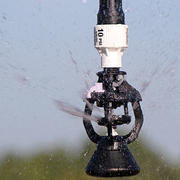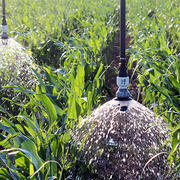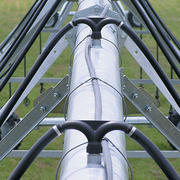
Center pivot irrigation technology has come a long way with recent improvements in irrigation efficiency and data tracking.
As sprinkler and center pivot irrigation manufacturers develop a better understanding of soil health and the water needs of various crops, technologies evolve so farmers can irrigate with less water and less energy while still keeping the high yields needed to feed the world.
Today, most pivot irrigators have abandoned the inefficient impact sprinklers familiar to most fruit and vegetable growers and replaced them with water and energy-efficient sprinkler heads, like LEPA applicators.
They have adopted new monitoring technologies that allow them to monitor almost every aspect of the system, from how much water needs to be applied to when water is delivered. Farmers can also verify a system’s efficiency and make any necessary adjustments to their pivots easily.
Despite these improvements, there are still many farmers across the world that have never considered center pivot irrigation systems.
We at Senninger have been working with pivot systems for over 30 years. We firmly believe pivots are and will continue to be efficient, and continuously improving systems that save water and energy will help growers obtain high yields. That's why we've decided to compile a list of top pivot irrigation myths and debunk them once and for all!
Myth #1: Pivots can’t irrigate corners without water wasting end guns.
Farmers who want to try center pivot irrigation but want to continue farming the corners of their fields can add swing arms that attach to the ends of the pivots and water the corners of the fields.
Myth #2: Pivot sprinklers waste water through runoff and surface soil evaporation.
Some pivot sprinklers are less efficient than others, particularly sprinklers that throw water high in the air. Good quality sprinklers irrigate with large droplets the air can’t steal and distribute water instantaneously over their entire surface area. Spreading out the droplets over a large area helps preserve soil’s intake rate and ability to absorb water.
Myth #3: Pivots can’t be used with crops prone to foliar diseases, like tomatoes.
Pivot sprinklers are extremely flexible! A spray head like the Senninger LDN® can be used in spray mode to germinate fields as a growing season begins. Then it can be switched to LEPA bubble mode, which avoids wetting crop leaves. The sprinkler can also be converted to a drag hose if necessary.
Myth #4: Pivots can only irrigate a limited number of crops like corn or cotton.
Did you know pivots are used to irrigate rice, tomatoes and sugarcane? Growers with center pivots are free to rotate crops every season, change row spacing or switch between high and low profile crops. It’s easy to modify pivots to irrigate different types of crops – most of the changes have to do with sprinkler height and application rate – and they are easy to move out of the way when it is time for planting or harvesting.
Center pivot irrigation with Xcel-Wobbler UP3 Top over sugarcane
Myth #5: Pivots are way more expensive than other systems.
The price of a pivot irrigation system may seem overwhelming initially, but investing in a pivot means investing in a cost-effective method that can last up to 25 years. Pivots are very easy to maintain. Most of what you pay is for the system itself – you won’t have to worry about filtration, checking the system for rodent damage, system flushing, air discharging, etc. Moreover, if there comes a moment when a component needs repairs, fixing the components will not lower the system’s overall application efficiency.
Myth #6: Pivot technology is always changing so there’s no point in buying something that will soon be outdated.
The main components of a pivot will last for decades. Add-ons like GPS control, automated system control and Variable Rate Irrigation Technology can be installed long after the pivot is purchased so growers always have the option of keeping up to date with the latest technologies. Sprinklers and pressure regulators can be easily replaced when they wear or if new technology becomes available.
Myth #7: Sprinklers use too much water and energy.
Sprinklers use anywhere from 0.27 to 30 gallons of water per minute and they only need 6 to 20 psi to operate, depending on the model selected.
Source
Published as "7 Center Pivot Myths Debunked". Valley Irrigation's Growing the Conversation. June 2015.




